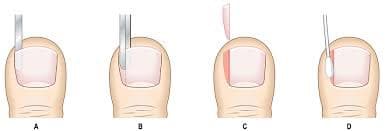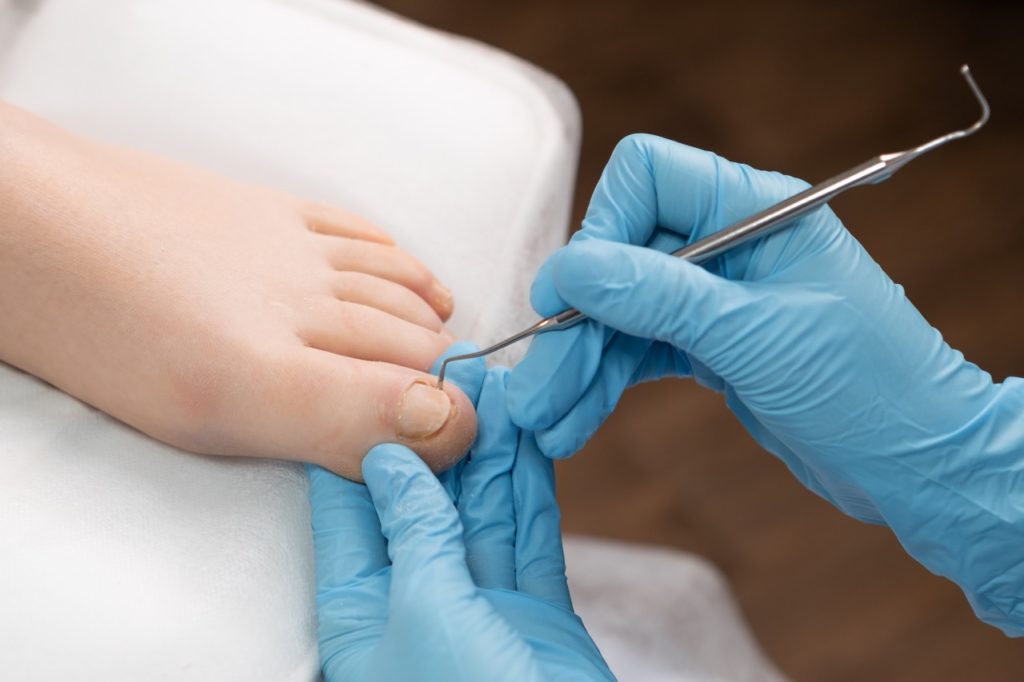Ingrowing toenails can be very painful, leading to surrounding tissue inflammation, infection and pus emission. While not all toenail problems require surgery, there are certain situations where it may be necessary. In this guide, we will discuss when to seek help and what to expect if you need to have toenail surgery.
Preventative conservative treatment
Preventing the need for ingrowing nail surgery is often a better option. When this is possible, regular trimming back at potentially ingrowing nails may prevent serious symptoms such as infection. This isn’t always possible and requires long-term treatment commitment. When this option isn’t possible, thinking about nail surgery, which provides a long-term treatment solution, should be explored.
Understanding what nail surgery is?
Toenail surgery, also known as Partial Nail Avulsion (PNA) or Wedge Resection, is a procedure that involves removing a narrow section of the ingrowing toenail – a FEW millimetres. Toenail surgery is a minor procedure to relieve discomfort from ingrown and painful toenails. The procedure involves removing the section of the nail causing the problem, and then a chemical called phenol is applied to the nail growth centre, which prevents it from growing back. The entire process is performed under local anaesthetic, ensuring that the affected toe is completely numb, and the patient experiences no pain during the surgery. Nail surgery is a safe and effective solution for alleviating pain and resolving infections associated with ingrown toenails.
Clinical research has been done looking at the results of this nail surgery procedure, showing that it offers a 95% success rate in preventing the problem from returning. Therefore, PNA offers the best long-term clinical solution to your ongoing or acute ingrowing nail problem.
Toenail surgery at Waverley Clinic
If you’re considering toenail surgery, choosing a reputable clinic with skilled, qualified professionals is crucial. Here at Waverley Clinic, our expert podiatrists offer minimally invasive toenail surgery—a straightforward solution for ingrown toenails. Using advanced surgical techniques, we preserve the healthy nail while removing only the problematic section. This approach relieves pain and discomfort effectively while delivering excellent 95% success in long-term clinical and cosmetic results.
The clinic room, environment, and instrumentation play vital roles in ensuring a safe and sterile environment for the procedure and adhering to strict safety and sterile procedural guidelines.
Minimally invasive nail surgery for ingrown toenails is carried out under local anaesthetic, similar to what you’d receive at the dentist. The affected toe is fully numbed before the procedure begins, ensuring a completely pain-free experience. We are committed to making the process as quick, comfortable, and stress-free as possible.

Preventing nail regrowth is a crucial step in addressing the issue of ingrown nails. During the minimally invasive nail surgery procedure, the affected nail bed is treated with a specialised phenol formula designed to prevent regrowth. This solution targets the cells responsible for nail growth, ensuring they do not regenerate in the problematic area.
Preparing for toenail surgery
Before undergoing toenail surgery, it’s crucial to consult with a qualified HCPC registered podiatrist to assess and discuss your condition and determine whether the procedure is necessary. During this consultation, you will receive detailed instructions to help you prepare for the surgery. These may include avoiding medications that could increase bleeding or interfere with the anaesthetic, arranging transportation for after the procedure, and wearing appropriate footwear on the day of surgery.
Ensure someone is available to drive you home, as you should not operate a vehicle until the numbness in your toe has completely worn off—doing so may invalidate your car insurance. Additionally, always remove any nail varnish before your podiatry appointment and inform your podiatrist about all allergies and medications you’re taking when completing your medical history. Following these guidelines will help ensure a smooth and safe surgical experience.
The toenail surgery procedure
The toenail surgery procedure typically takes less than an hour, and you can return home the same day. Once you arrive at the clinic, your podiatrist will review your medical history and discuss the details of the procedure with you and the consent form signed. They will then administer local anaesthetic to numb the affected area and the surrounding skin.
Next, they will carefully remove either part or all of the affected toenails. The problem area nail base surgical site is then treated with phenol solution to inhibit nail regrowth and promote healing. The typical recovery time following toenail removal is around 4-6 weeks.
After the procedure is complete, your toe will be bandaged, and you will receive aftercare instructions from your podiatrist before being driven home by a friend or relative.
What to expect from nail surgery
When you attend a nail surgery appointment, you can expect a straightforward and efficient process designed to address your nail issues comprehensively. Initially, your podiatrist will conduct a medical check to confirm that nail surgery is the best option for your condition. Once confirmed, local anaesthetic injections will be administered to numb the affected toe, ensuring a pain-free experience. A tourniquet will be applied to control bleeding during the procedure.
The podiatrist will then carefully remove the appropriate part of the nail from the nail bed. To prevent the nail from regrowing, a chemical called phenol is applied to the nail bed. After the procedure, a large dressing will be applied to protect the area and promote healing. The entire process typically takes about an hour, and you will remain awake but comfortable throughout. It is important to arrange for someone to take you home after the surgery, as you should not drive until the anaesthetic has completely worn off.
After toenail surgery
After toenail surgery, any discomfort is managed with over-the-counter pain medication such as paracetamol, and your foot is kept elevated until going to bed. Usually, patients do not experience post-operative pain and sleep well through the night.
Patients return to the clinic the following day for a surgical review appointment. The large dressing is removed, and the operation site is checked and redressed. The clinic then supplies the patient with anti-bacterial dressings to be changed at home for ten days. Normal shoes can then be used. Full post-operative advice, verbal and printed, is always provided, but always call the clinic if you have any questions or concerns.
Recovery time after toenail surgery
The recovery time for toenail surgery varies, but most patients can resume regular activities within a few days to a week. Depending on the extent of the procedure and your individual healing process, it may take up to six weeks for complete healing. However, it must be stressed that high-impact activities such as football and basketball must be avoided until the area is fully healed. Often school children schedule nail surgery just before school holidays.
When can I return to work or school?
The timeline for returning to work after toenail surgery largely depends on the nature of your job. If you have a desk job, you may be able to return to work as soon as the next day. However, if your job involves standing, walking, or any physical activity, you might need to take a few days off to allow your toe to heal properly. However, it is generally recommended not to return to work or school immediately after the surgery but to avoid high-impact sports or work activities. This precaution helps ensure that your toe heals correctly and reduces the risk of complications or healing process delays.
Cost and insurance
The cost of ingrowing toenail surgery here at Waverley Clinic is £395.00, which includes the surgical procedure, local anaesthetic, dressings, and a follow-up appointment.
Most health insurance plans cover at least a portion of toenail surgery expenses. However, it’s always best to check with your provider beforehand to determine coverage and any necessary paperwork or referrals. You will need an insurance authorisation number to cover the procedure. Note: sometimes insurance companies refer to this procedure as ‘Wedge Resection’.

When to seek help
If you’re dealing with severe toe pain, discomfort, or complications from a thickened or ingrown toenail, we’re here to help. Even if other treatments haven’t worked or the issue persists, don’t hesitate to contact us here at Waverley Clinic for expert Podiatry care and support. Our experienced Podiatrists will work with you to determine the best course of action for your individual needs and provide top-quality treatment and aftercare.
Don’t let toenail problems limit your mobility and cause unnecessary pain – book a consultation with us today!
Taking care of your feet is crucial for overall health and well-being. When it comes to nail health, addressing issues promptly and seeking professional treatment when necessary can help prevent more significant problems.
Schedule your toenail surgery ‘Assessment Appointment’ at Waverley Clinic today!
Don’t ignore bothersome or recurring toenail problems – our team at Waverley Clinic is here to help you get back on your feet. Our expert podiatrists can diagnose and treat various nail conditions, providing customised care for the best possible outcome.
Don’t let toenail problems hold you back any longer—schedule an appointment with us easily by calling our 24/7 appointment booking service at 01252 716611.
Say goodbye to painful, unsightly nails and hello to comfort and confidence. See you soon at Waverley Clinic. We are committed to helping you put your best foot forward. Stay healthy!

